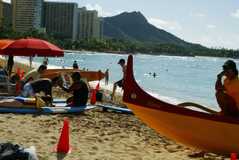Top 20 liveable cities / Honolulu
09 - Honolulu
The city has the luxury of sitting on Asia’s doorstep. This is great news but it needs to put it to use.

Hawaii has loomed large in the imagination (and holidays) of Americans and others since Captain James King recorded “the boldness and address” of native surfers in 1779. The sport may live and breathe here on the southeastern coast of the island of Oahu, but Honolulu is no longer a far-flung destination for surfers and vacationers. Bridging the oceanic gap between California and Asia, Honolulu now fits the definition of a global city – a palm-fringed metropolis with a population as diverse as its flora.
Tourism still drives Honolulu’s economy, producing a $12bn (€9bn) profit in 2006 (a quarter of the state’s revenue). Eight million people visit Honolulu annually for the sublime volcanic peaks, world-class hotels, restaurants, and beaches; locals coexist with 175,000 visitors each day. This boom, along with lucrative fishing and coffee industries, has kept the city’s unemployment rate the lowest in America. Hospitality industry workers earn some of the highest wages in the country, alleviating the high cost of living. To boost development, Hawaii is offering tax breaks and incentives to businesses in space exploration, ocean science, film and television.
Honolulu is not immune from the problems facing modern metropolises. Its position as a gateway between Asia and America is evident in the congestion that plagues the H-I freeway during rush hour. For the past two years Mayor Mufi Hannemann has been the state’s most vocal proponent for the fixed-rail system currently in development.
As the city develops, Honolulu’s once-sleepy arts sector is flourishing. A grid of streets around Honolulu Harbour has gone from seedy to stylish in a decade. The Hawaii Theatre, built in 1922, is emblematic of these changes: it recently had a $21m (€15.6m) renovation and is now a state-of-the-art space, regaining its longtime nickname, “Pride of the Pacific” – a title the city itself can claim.
Honolulu metrics
Population: 380,000.
International flights: over 200 international flights to 27 destinations, plus domestic connections.
Crime rates: murders,15; domestic break-ins, 6,209 (2005).
State education: school system is underfunded. The main debate among lawmakers is whether the centralised state-run system, the only of its kind in the US, should be maintained. Two universities serve the island’s 53,000 students.
Health care: Hawaiians boast longer life-expectancy rates than anywhere else in the US. Eight hospitals offer excellent care.
Sunshine: annual average, 2,830 hours.
Temperature: in January the average temperature is 23C, in July 27C.
Wired: a number of hotels and internet cafés offer free or cheap access, but the city is by no means a wireless hub.
Tolerance: in the 1990s mixed marriages between the island’s diverse ethnic communities began to outnumber unions between partners of the same ethnicity, increasing diversity and blurring racial lines. Also offers same-sex benefits.
Drinking and shopping: from exotic tropical drinks in kitschy tourist traps to cocktails beneath beachside cabanas, Honolulu can sate anyone’s thirst. Most bars are open until 02.00, clubs are open until 04.00. The Japanese market means there’s a high-number of luxury goods stores.
Transport: a $5.2bn (€4bn) fixed rail system is in the works. Honolulu has the best bus network in America, and few taxis. The city has purchased 40 environmentally friendly buses equipped with GPS systems, which will cut fuel costs by over 20 per cent.
Local media: Honolulu has two dailies and one weekly paper, all of which reflect a narrow local focus. The same is true for the city’s magazines and television stations.
International media: a selection of international dailies and magazines are available at a few newsstands and hotels.
Green space: though the city has few parks, its environs comprise one of the most magnificent natural spaces in the US.
Access to nature: has access to little else.
Environmental initiatives: the city is embarking on an ambitious programme to modernise waste management, reduce its reliance on landfills, and limit the effects of waste water on the island’s ecosystems by replacing the decrepit sewer system.
Monocle metrics: bungalows by Vladimir Ossipoff (see Expo), short flying time to Japan, excellent weather and boundless opportunities in a variety of sectors could make anyone take to wearing a muu-muu.


